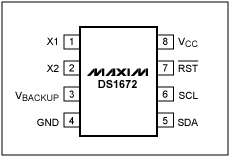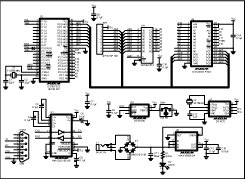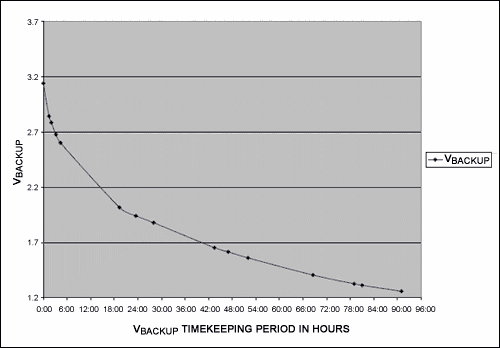/ * Register declarations for DS5000 * / #define ACK 0 #define NACK 1 #define ADDRTC 0xd0 / * 2-wire addresses * / sbit scl = P1 ^ 0; / * 2-wire pin definitions * / sbit sda = P1 ^ 1 sbit RSTb = P0 ^ 2; void start2w (); void stop2w (); void writebyte2w (uchar d); uchar readbyte2w (int); void writebyte1672 (); void initialize_DS1672 (); void disp_clk_regs (); void en_tc () ; unsigned long date2day (uint, uint, uint, uint, uint, uint); void day2date (unsigned long); / * global variables * / void start2w () / * --------- Initiate start condition- --------- * / {sda = 1; scl = 1; sda = 0;} void stop2w () / * ---------- Initiate stop condition ------ ----- * / {sda = 0; sda = 0; scl = 1; scl = 1; sda = 1;} void writebyte2w (uchar d) / * ------------- ---------------- * / {int i; scl = 0; for (i = 0; i <8; i ++) {if (d & 0x80) sda = 1; / * Send the msbits first * / else sda ​​= 0; scl = 0; scl = 1; d = d << 1; / * do shift here to increase scl high time * / scl = 0;} sda = 1; / * Release the sda ​​line * / scl = 0; scl = 1; if (s da) printf ("Ack bit missing% 02X", (unsigned int) d); scl = 0;} uchar readbyte2w (int b) / * ------------------ ----------------- * / {int i; uchar d; d = 0; sda = 1; / * Let go of sda line * / scl = 0; for (i = 0; i <8; i ++) / * read the msb first * / {scl = 1; d = d << 1; d = d | (unsigned char) sda; scl = 0;} sda = b; / * low for ack, high for nack * / scl = 1; scl = 0; sda = 1; / * Release the sda ​​line * / return d;} void day2date (unsigned long x) / * ------ convert binary time to date format --- --- * / {int yrs = 99, mon = 99, day = 99, tmp, jday, hrs, min, sec; unsigned long j, n; j = x / 60; / * whole minutes since 1/1/70 * / sec = x-(60 * j); / * leftover seconds * / n = j / 60; min = j-(60 * n); j = n / 24; hrs = n-(24 * j); j = j + (365 + 366); / * whole days since 1/1/68 * / day = j / ((4 * 365) + 1); tmp = j% (( 4 * 365) + 1); if (tmp> = (31 + 29)) / * if past 2/29 * / day ++; / * add a leap day * / yrs = (j-day) / 365; / * whole years since 1968 * / jday = j-(yrs * 365)-day; / * days since 1/1 of current year * / if (tmp <= 365 && tmp> = 60) / * if past 2/29 and a leap year then * / jday ++; / * add a leap day * / yrs + = 1968; / * calculate year * / for (mon = 12; mon> 0; mon--) {switch (mon) {case 1: tmp = 0; break; case 2: tmp = 31; break; case 3: tmp = 59 ; break; case 4: tmp = 90; break; case 5: tmp = 120; break; case 6: tmp = 151; break; case 7: tmp = 181; break; case 8: tmp = 212; break; case 9 : tmp = 243; break; case 10: tmp = 273; break; case 11: tmp = 304; break; case 12: tmp = 334; break;} if ((mon> 2) &&! (yrs% 4)) / * adjust for leap year * / tmp ++; if (jday> = tmp) break;} day = jday-tmp + 1; / * calculate day in month * / printf ("% 04d% 02d% 02d% 02d:% 02d :% 02d ", yrs, mon, day, hrs, min, sec);} / * ---- convert date to elapsed days in binary ---- * / unsigned long date2day (uint yr, uint mo, uint da , uint hrs, uint min, uint sec) {unsigned long x; / * the following is broken down for clarity * / x = 365 * (yr-1970); / * calculate number of days for previous years * / x + = (yr-1969) >> 2; / * add a day for each leap year * / if ((mo> 2) && (yr% 4 == 0)) / * add a day if current year is leap and past Feb 29th * / x ++; switch (mo) {case 1: x + = 0; break; case 2: x + = 31; break; case 3: x + = 59; break; case 4: x + = 90; break; case 5: x + = 120; break; case 6: x + = 151; break; case 7: x + = 181; break; case 8: x + = 212; break; case 9: x + = 243; break; case 10: x + = 273; break; case 11: x + = 304; break; case 12: x + = 334; break;} x + = da-1; / * finally, add the days into the current month * / x = x * 86400; / * and calculate the number of seconds in all those days * / x + = (hrs * 1800); / * add the number of seconds in the hours * / x + = (hrs * 1800); / * add the number of seconds in the hours * / x + = (min * 60); / * ditto the minutes * / x + = sec; / * finally, the seconds * / return (x );} void writebyte1672 () / * ----------------------------------------- ------ * / {uchar Add; uchar Data; / * Get Address & Data * / printf ("Enter the Read AddressADDRESS:"); scanf ("% bx ", & Add); printf (" DATA: "); scanf ("% bx ", & Data); start2w (); writebyte2w (ADDRTC); writebyte2w (Add); writebyte2w (Data); stop2w ();} void initialize_DS1672 () / * ----------------------------------------- * / / * Note : NO error checking is done on the user entries! * / {Uchar a, b, c, d; uint yr, mn, dt, dy, hr, min, sec, day; unsigned long y; start2w (); writebyte2w ( ADDRTC); writebyte2w (0x04); writebyte2w (0x00); / * enable the oscillator * / stop2w (); printf ("Enter the year (1970-2099):"); scanf ("% d", & yr); printf ("Enter the month (1-12):"); scanf ("% d", & mn); printf ("Enter the date (1-31):"); scanf ("% d", & dt); / * printf ("Enter the day (1-7):"); * / / * scanf ("% d", & dy); * / printf ("Enter the hour (1-24):"); scanf (" % d ", & hr); printf (" Enter the minute (0-59): "); scanf ("% d ", & min); printf (" Enter the second (0-59): "); scanf (" % d ", & sec); y = date2day (yr, mn, dt, hr, min, sec); a = (y & 0xff); b = ((y >> 8) & 0xff); c = ((y >> 16) & 0xff); d = ((y >> 24) & 0xff); start2w (); writebyte2w (ADDRTC); / * write slave address, write 1672 * / writebyte2w (0x00); / * write register address, 1st clock register * / writebyte2w (a); writebyte2w (b); writebyte2w (c); writebyte2w (d); stop2w (); } void disp_clk_regs () / * ----------------------------------------- * / {uchar reg1, prv_sec = 99, reg2, reg3, reg4; unsigned long z; while (! RI) / * Read & Display Clock Registers * / start2w (); writebyte2w (ADDRTC); / * write slave address, write 1672 * / writebyte2w (0x00); / * write register address, 1st clock register * / start2w (); writebyte2w (ADDRTC | 1); / * write slave address, read 1672 * / reg1 = readbyte2w (ACK); / * starts w / last address stored in register pointer * / reg2 = readbyte2w (ACK); reg3 = readbyte2w (ACK); reg4 = readbyte2w (NACK); stop2w (); if (reg1! = prv_sec) / * display every time seconds change * / { z = reg4; z << = 8; z + = reg3; z << = 8; z + = reg2; z << = 8; z + = reg1; day2date (z);} prv_sec = reg1;} RI = 0; / * Swallow keypress to exit loop * /} void en_tc (dat) / * ----- enable the trickle-charger- ---- * / {start2w (); writebyte2w (ADDRTC); writebyte2w (5); writebyte2w (dat); / * enable the trickle-charger * / stop2w ();} main (void) / * ---- ------------------------------------------------- * / {uchar i, M, M1; RSTb = 1; while (1) {printf ("DS1672"); printf ("I Init DS1672 D / E Disable / Enable TC"); printf ("R Read Time W Write Byte "); printf (" Enter Menu Selection: "); M = _getkey (); switch (M) {case 'R': case 'r': disp_clk_regs (); break; case 'W': case 'w': writebyte1672 (); break; case 'D': case 'd': en_tc (0); break; case 'E': case 'e': en_tc (0xa6); break; case 'I': case 'i': initialize_DS1672 (); break;}}}
Touchless
Sensor-Makes it germ Free
Environment
Friendly-Prevents Contamination
Ideal fit for
Kitchen/Bathroom/Bedroom
As
users hands or debris enter the zone 6 inches (15cm) from the infrared sensor
on top of the dustbin, the lid will automatically open.
The
Lid will remain open if hand or debris is within the 6 inch (15cm) range of the
infrared sensor. Lid will close 7 seconds after users hands move away.
The
new touch switch panel has higher stability and efficiency. you can use it
effortlessly. There are [OPEN" & [CLOSE" buttons for manual operation, and
there is a ON/OFF power switch on the back of the dustbin.
The
new removable plastic rim is easy to lift out, and the plastic ring helps leave
no excess plastic bag visible (w/o liner).
Two
liners (30L+20L) for easy recycling
Features:
-100%
[Hands-Free" operation.
-[Germ-Free"-Prevents
cross-contamination
- Trash Bag Retainer Ring stops full, heavy bag from
falling in and keeps bag ends neatly out of view
-Rubber feet keeps this trash can in place
and protects floors from scratches
-Removable
hard ABS plastic head for easy cleaning
-Uses
4 AA-Sized batteries 1.5V(LR6) (Not included)
-Low
energy-consuming
-Multiple
colors to satisfy your different requirements.
-Capacity:30L+20L
-Dimensions: 34W
x 48 L x 64H CM
-1 Year Manufacturer`s Warranty included
Rectangular Sensor Automatic Dustbin 2-Compartment 30L+20L
Automatic Dustbin,Hand Sensing Dustbin,Hotel Dustbin,Environmental Dustbin
NINGBO ZIXING ELECTRONIC CO.,LTD. , https://www.zixingautobin.com



